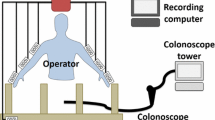Abstract
Colonoscopy is a minimally invasive endoscopic procedure to survey, diagnose and treat possible disease in the colon. Clinicians are trained to manipulate a colonoscope while minimizing the force exerted on the colon walls to reduce the danger of luminal perforation and discomfort to the patient. Here, we propose and evaluate a metric, called Global Isotropy Index (GII), to quantify the expertise of the clinician. The colonoscope is modeled as a continuum robot with multiple bending sections. The Jacobian operator, which relates the proximal forces applied by the clinician to the distal forces, provides a basis to compute the GII. Experimental results in a colon model (CM-1, Olympus, Tokyo, Japan) are shown to compare the efficacy of this metric in characterizing operator performance compared to standard metrics such as elapsed time, path length, and kinematics factors. The GII values for experts are significantly different from those of novices; our initial studies show that it can be as much as 1.45 times greater for the experts.
This work has been funded by NIH/NCI under award 2 R42 CA115112-02A2 and the Center for Integration of Medicine and Innovative Technology (CIMIT), Boston, MA.
Access this chapter
Tax calculation will be finalised at checkout
Purchases are for personal use only
Preview
Unable to display preview. Download preview PDF.
Similar content being viewed by others
References
Darzi, A., Smith, S., Taffinder, N.: Assessing operative skill: Need to become more objective. British Medical Journal 318, 887–888 (1999)
Satava, R., Cuschieri, A., Hamdorf, J.: Metrics for objective assessment: Preliminary results of the surgical skills workshop. Surgical Endoscopy 17, 220–226 (2003)
Peters, J., Fried, G., Swanstrom, L., Soper, N., Silin, L., Schirmer, B., Hoffman, K., et al.: Development and validation of a comprehensive program of education and assessment of the basic fundamentals of laparoscopic surgery. Surgery 135, 21–27 (2004)
Van Sickle, K., McClusky, D., Gallagher, A., Smith, C.: Validation of the promis simulator using a novel laparoscopic suturing task. Surgical Endoscopy 19, 1227–1231 (2005)
Gunther, S., Rosen, J., Hannaford, B., Sinanan, M.: The red dragon: A multi-modality system for simulation and training in minimally invasive surgery. Stud. Health Tech. and Info. 125, 149–154 (2007)
Neary, P., Boyle, E., Delaney, C., Senagore, A., Keane, F., Gallagher, A.: Construct validation of a novel hybrid virtual-reality simulator for training and assessing laparoscopic colectomy; results for the first course for experienced laparoscopoic surgeons. Surgical Endoscopy 22, 2301–2309 (2008)
Aggarwal, R., Grrantcharov, R., Murthy, K., Milland, T., Papasavas, P., Dosis, A., Bello, F., Darzi, A.: An evaluation of the feasibility, validity, and reliability of laparoscopic skills assessment in the operating room. Annals of Surgery 245, 992–999 (2007)
Heinrichs, W., Srivastava, S., Montgomery, K., Dev, P.: The fundamental manipulations of surgery: A structured vocabulary for designing surgical curricula and simulators. J. Amer. Assoc. of Gynecologic Laparoscopists 11, 450–456 (2004)
Dosis, D., Aggarwal, R., Bello, F., Moorthy, K., Munz, Y., Gillies, D., Darzi, A.: Synchronized video and motion analysis of the assessment of procedures in the oeprating theater. Arch. Surg. 140, 293–299 (2005)
Megali, G., Sinigaglia, S., Tonet, O., Dario, P.: Modelling and evaluation of surgical performance using hidden markov models. IEEE Transactions on BioMedical Engineering 53, 1911–1919 (2006)
Allen, B., Nistor, V., Dutson, E., Carman, G., Lewis, C., Faloutsos, P.: Support vector machines improve the accuracy of performance evaluation of laparoscopic training tasks. Surgical Endoscopy, 1–14 (2009)
Stylopoulos, N., Vosburgh, K.: Assessing technical skill in surgery and endoscopy: A set of metrics and an algorithm (C-PASS) to assess skills in surgical and endoscopic procedures. Surgical Innovation 14 (2007)
Vosburgh, K., Stylopoulos, N., San Jose Estepar, R., Ellis, R., Samset, E., Thompson, C.: EUS and CT improve efficiency and structure identification over conventional EUS. Gastrointestinal Endoscopy 65, 866–870 (2007)
Stocco, L., Salcudean, S.E., Sassani, F.: Fast constrained global minimax optimization of robot parameters. Robotica 16, 595–605 (1998)
Salcudean, S.E., Stocco, L.: Isotropy and actuator optimization in haptic interface design. In: IEEE International Conference on Robotics and Automation, pp. 763–769 (2000)
Kim, S., Jeong, I., Lee, S.: Systematic isotropy analysis of a mobile robot with three active caster wheels. In: Huang, D.-S., Heutte, L., Loog, M. (eds.) ICIC 2007. LNCS, vol. 4681, pp. 587–597. Springer, Heidelberg (2007)
Trejos, A.L., Patel, R.V., Ross, I., Kiaii, B.: Optimizing port placement for robot-assisted minimally invasive cardiac surgery. Int. J. Med. Robotics Comput. Assist. Surg. 3, 355–364 (2007)
Jayender, J., Patel, R.V., Michaud, G., Hata, N.: Optimal Transseptal Puncture Location for Robot-Assisted Left Atrial Catheter Ablation. In: Yang, G.-Z., Hawkes, D., Rueckert, D., Noble, A., Taylor, C. (eds.) MICCAI 2009. LNCS, vol. 5761, pp. 1–8. Springer, Heidelberg (2009)
Sciavicco, L., Siciliano, B.: A solution algorithm to the inverse kinematic problem for redundant manipulators. IEEE Transactions on Robotics and Automation 4, 403–410 (1988)
Merlet, J.P.: Jacobian, manipulability, condition number, and accuracy of parallel robots. Journal of Mechanical Design 128, 199–206 (2006)
Author information
Authors and Affiliations
Editor information
Editors and Affiliations
Rights and permissions
Copyright information
© 2010 Springer-Verlag Berlin Heidelberg
About this paper
Cite this paper
Jayender, J., Estépar, R.S.J., Vosburgh, K.G. (2010). New Kinematic Metric for Quantifying Surgical Skill for Flexible Instrument Manipulation. In: Navab, N., Jannin, P. (eds) Information Processing in Computer-Assisted Interventions. IPCAI 2010. Lecture Notes in Computer Science, vol 6135. Springer, Berlin, Heidelberg. https://doi.org/10.1007/978-3-642-13711-2_8
Download citation
DOI: https://doi.org/10.1007/978-3-642-13711-2_8
Publisher Name: Springer, Berlin, Heidelberg
Print ISBN: 978-3-642-13710-5
Online ISBN: 978-3-642-13711-2
eBook Packages: Computer ScienceComputer Science (R0)




